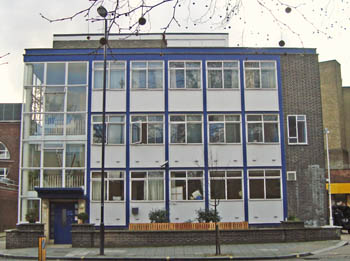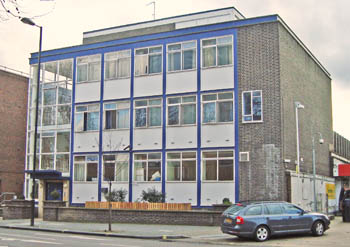Psychiatric (Out-patients only)
The Paddington Clinic and Day Hospital opened in 1962, replacing the Camden Clinic which closed. It was one of the first NHS units to provide psychoanalytic therapy.
The Clinic and Day Hospital were located in a new 3-storey building next to a petrol station on the Harrow Road, adjacent to the Westway motorway. The building also housed the Child Guidance Clinic, transferred from the St Marylebone Hospital for Psychiatry and Child Guidance.
Most of the ground floor was occupied by the Day Hospital, which had been established initially as an out-patient facility for the rehabilitation of patients discharged from Horton Hospital. The cafeteria and the Art Therapy Room on this floor were shared with the other departments in the building.
In 1965 an Out-Patients Department opened to provide psychotherapeutic treatment for adults.
In the same year a 'therapeutic community' was established in the Day Hospital by a consultant psychiatrist who did not believe in organic means of treatment, such as E.C.T. or chemotherapy. The community was run democratically by both staff and patients and the days were filled with group work and activities, comprising community meetings, shared decision-making and group therapy.
The Day Hospital had little in the way of furniture or ornamentation, and its floors were bare. The main group meeting room was a large L-shaped room marred by a central pillar. It contained a sagging sofa and a variety of armchairs of varying degrees of comfort. Rather surprisingly, the room lacked heating, which was often a source of complaint during meetings.
The consultant felt it was the responsibility of the patients to tidy up after themselves rather leave it all to the cleaner, so the Hospital became increasingly unclean and untidy. Patients occasionally used materials from the Art Therapy Room to paint graffiti on the walls to express themselves and their opinions about the Hospital. These were left on the walls so that they could be discussed by the group. The appearance of the Day Hospital thus contrasted strongly with the more aesthetic environment of the rest of the centre, where it was becoming increasingly viewed as 'different'. It was becoming estranged from the traditional psychiatric establishment.
The Day Hospital accepted patients who had been assessed as psychologically unsuitable for psychotherapy. Its 'open door' policy means that people could attend when they wanted. Staff began to refuse to diagnose psychiatric conditions or to prescribe medication, or even to keep medical records for their patients. Initially the Day Hospital had received patients from its catchment area, but soon took on those from other areas who had heard of the therapeutic community and self-referred themselves. Since few records were kept, it was not known where patients came from, but some had come from as far away as Ipswich in Suffolk. The patients were mainly white, well-educated, young adults, although a number from the local African Caribbean community also attended. Most patients remained at the unit for about one to two years.
Some patients shared a commune, living together in cheap accommodation. The Day Hospital supported this, so that the intense group dynamics could continue for 24 hours a day.
In December 1971 the staff and patients formed a protest group against closure of the Day Hospital and its transfer to the newly opened psychiatric unit at St Mary's Hospital. At this time the Day Hospital had 50 members of staff and 80 places for patients. The new facility at St Mary's Hospital had 60 beds and 80 places for day patients.
The Paddington Day Hospital protest became symbolic of the anti-psychiatric movement during a great public awareness of mental health issues and resistance to psychiatry. The campaign's slogan was Paddington Day keeps madness at bay. The protest was successful and the Day Hospital remained open, whilst similar units around the country closed.
In March 1973 some 100 people, mostly patients or former patients, met at the Day Hospital to discuss forming a union for mental patients. Following this, the Mental Patients Union was established, with full membership reserved for patients and ex-patients.
In 1974 the Clinic and Day Hospital were renamed the Paddington Centre for Psychotherapy.
In January 1976 the patients called for an inquiry into the functioning of the Day Hospital and its lack of shared decision-making. This provoked an investigation by the Area Health Authority, which led to the Medical Director being dismissed.
Although the new Medical Director attempted to re-establish a therapeutic community, this proved not possible and the Day Hospital began to be wound down in 1978 and the patients discharged.
The Clinic and Day Hospital closed in 1979. Services moved to the Parkside Clinic in Lancaster Road.
Present
status (November 2008)
The building is now owned by St Mungo's Housing Association. It provides hostel accommodation for 41 homeless men aged over 50, many of whom are mentally ill. Breakfast and an evening meal are provided, and residents are permitted to drink alcohol in their rooms and in two communal lounges (another lounge is a designated 'dry' area).

St Mungo's Hostel, Harrow Road (above and below).

Davies L (undated) Authentic Social Work. London Metropolitan University.
Spandler H 2006 Asylum to Action: Paddington Day Hospital, Therapeutic Communities and Beyond. London, Jessica Kingsley.
Spandler H 2009 Spaces of psychiatric contention: a case study of a therapeutic community. Health & Place 15, 841-847.
http://hansard.millbanksystems.com
http://studymore.org.uk
www.guardian.co.uk
Return to home page